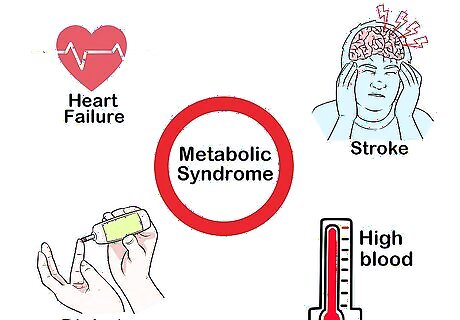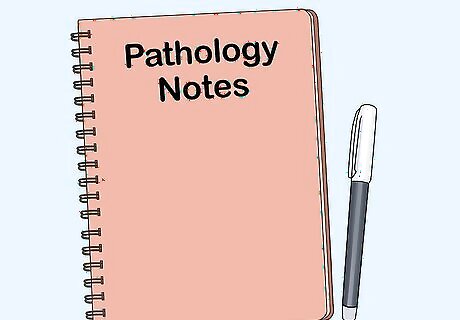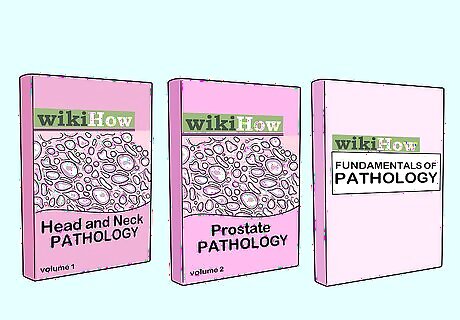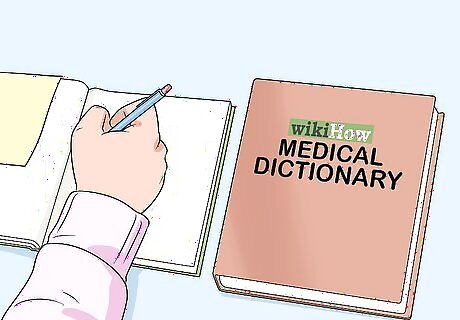
views
Studying Individual Conditions or Diseases

Classify each condition. Learning the classifications of conditions can help you keep all of the information associated with that condition together. Using the mnemonic device VITAMIN C, D can help you classify conditions and diseases before you break them down. Each of the letters in "VITAMIN C, D" stands for a different disease classification: Vascular, Infectious, Traumatic, Autoimmune, Metabolic, Iatrogenic/Idiopathic, Neoplastic, Congenital, and Degenerative.

Define the condition. For every condition or disease you study, make sure you can come up with a detailed definition. Learn exactly what the term means, and how it fits in with other things that you've studied. Because the study of pathology is the study of diseases and their causes, knowing the exact definition of a condition is essential for a proper diagnosis. In your pathology notebook, create a section for each condition. At the beginning of each section, write down the definition of the condition.

Figure out the how and why of the condition you're studying. The how and why of any condition is called pathogenesis – basically how the condition develops. Once you know the definition of a particular condition, focus on learning the why – the causes of the condition – and the how. Learn how these causes turn into this particular condition, rather than another. In your notebook, organize a section for the pathogenesis of each condition under the condition's definition. How exactly you set this section will vary depending on what works best for you. You could list the causes, and under each cause why that cause turns into that particular condition. Or you can create a concept map with boxes and arrows connecting each concept to its pathogenesis.

Learn the morphology of each condition. For each condition you study, the morphology – the changing of cells and tissue – will be different. So if you know how a particular condition changes cells and tissue, you have a better shot at being able to recognize a condition. The morphology should be listed after the definition and pathogenesis of the condition you're studying. In this case, it might be useful to draw pictures or, if you're not a great artist, copy and print out images from your textbook that show the morphology.

Memorize the clinical manifestations of each condition. The clinical manifestations of a condition are just the symptoms associated with that condition. There can be a lot of overlap in symptoms, meaning different conditions can have the same clinical manifestations. So learning the clinical manifestations is just one part of learning about individual conditions. Writing down information is 1 way to begin memorizing it. You can also make flash cards with the clinical manifestations of the condition you're studying. Keep those flashcards in your notebook in the section dedicated to that condition.

Learn the complications of each condition. Not every patient you see will be at the same exact point in the development of individual conditions. It's therefore important to learn the complications that might develop if any condition is left untreated. It might look very different after 6 months of no treatment than it does after 1. In your notebook, create a timeline, starting at the point when the condition would first develop and listing the complications at the start. Then draw lines on your timeline for when the complications may change and list the timing and complications.
Using General Study Techniques

Use one notebook for all of your pathology notes. Having all of your notes in one place will really help when it comes to studying. Organize your notebook by condition or subject, and only ever take your pathology notes in that notebook.

Play online games. Websites like Sporcle have a large collection of quizzes and games that are designed to help you learn medical terminology and vocabulary. You can choose the topic of quizzes and games to make them specifically about pathology. Because you're learning at the same time you're having fun, you might memorize pathology concepts more easily.

Make flashcards. To memorize pathology concepts, create a set of flashcards for each concept or subject you're learning. On the front of each index card, write 1 concept or term you're trying to memorize. On the back, write the definition. Then study the cards - look at the front and then try to remember the definition before you flip it over to check. Carry your flashcards around with you. If you have a break between classes, or time on a bus ride or while you're hanging out at home, use them. The more you use your flashcards, the more you'll memorize. You can also use websites like Flashcard Machine to automatically generate pathology-related flashcards for general study. If you can memorize the meanings of common roots to pathology terms (like hyper-, hypo-, and -oma), you're already 1 step closer to learning the whole definition of the word. Write each root on the front side of a flash card, and the definition on the back.

Consider purchasing pathology study guides or books. Your instructor may recommend certain guides or books in class. Princeton Review has a series of books for studying pathology. The website Pathoma has an online textbook, a series of study guides, and videos for a subscription fee.

Take practice exams or do extra homework. Your text book may include practice essays or exams. You can also ask your instructor for practice exams. If you're assigned homework, do a few extra problems.
Improving Study Habits

Brush up on the anatomy and physiology associated with the pathology you're learning. If you don't have the basics of anatomy and physiology down, you can easily get lost when studying pathology. So if you know this week in your pathology class you're going to be studying respiratory pathology, review lung anatomy and physiology the weekend before. That way you can focus on the pathology information, instead of trying to remember stuff you learned in past semesters.

Space out your studying. Pathology, like most medical fields, requires that you learn a lot of information. One of the best ways to commit all that information to memory is spread out your studying. Review your class notes each day, and rewrite notes on particularly difficult topics. You can also re-teach yourself concepts by going over your notes and speaking out loud as if you were explaining the concept to someone else.

Keep a medical dictionary near you while you study. As you're reading, look up pathology terms you don't know, even if they're not directly related to the topic you're studying. Chances are that term will come up again, and knowing how it functions in different contexts will help you learn pathology more generally. You can use a paper dictionary, or a medical dictionary website like MediLexicon.

Form a study group. There will always be people in your class who get certain things more quickly than you do, and you will always get things more quickly than others. Forming a study group helps you benefit from your classmates' strength. Get together once or twice a week to study together.




















Comments
0 comment